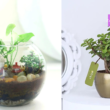Happy Jade Plant, scientifically known as Crassula ovata, holds a venerable spot across various cultures around the world, celebrated not just for its appealing, lush greenery and low maintenance, but also for its rich tapestry of symbolic meanings. Often linked to prosperity, good luck, and renewal, this plant features prominently in rituals, gifting traditions, and daily decor, making it a universal symbol of positive energy and growth.
Historical and Cultural Significance of the Happy Jade Plant
1. Symbol of Prosperity and Financial Fortune
In many cultures, particularly within Asian communities, the Happy Jade Plant is revered as a magnet for wealth. Resembling jade coins with its round, flat leaves, it is commonly placed in business establishments and homes, often near the entrance, as a beacon of good fortune and financial success. This practice is deeply embedded in Feng Shui, the ancient Chinese art of arranging living spaces to create balance with the natural world. The plant is believed to activate financial energies, bringing stability and prosperity to its owners.
2. A Gift of Good Luck
Due to its associations with prosperity, the Happy Jade Plant is a popular gift for housewarmings, weddings, and business openings. Presenting a Happy Jade Plant as a gift is akin to blessing the receiver with future success and wealth. It’s especially common to give this plant as a gift for new business ventures as a token of good luck and to wish the new business prosperity and growth.
3. An Emblem of Friendship and Goodwill
Beyond financial implications, the Happy Jade Plant is also seen as a symbol of deep friendship and lasting relationships. The resilient nature of the plant, with its ability to thrive under minimal care, mirrors the qualities of enduring friendships. It’s not uncommon for friends to exchange Happy Jade Plants as gifts, symbolizing their mutual respect and the valued longevity of their bond.
4. Integral to Rituals and Traditional Practices
In various cultural rituals, the Happy Jade Plant plays a significant role. For example, during Lunar New Year celebrations, it’s customary for families in some East Asian cultures to decorate their homes with Happy Jade Plants. The plants are believed to usher in good luck for the coming year and are often adorned with red ribbons or lucky charms to amplify their energy.
5. Representation in Religious and Spiritual Practices
The Happy Jade Plant is sometimes used in spiritual rituals to attract divine blessings. In parts of India, it is common to see the Happy Jade Plant included in home altars. Devotees believe that the plant’s vibrant energy brings the blessing of the deities into the home, promoting a peaceful and prosperous living environment.
Care and Keeping of the Happy Jade Plant
To ensure that the Happy Jade Plant continues to serve as a beacon of good fortune and aesthetic pleasure, proper care is essential. Here are some tips to maintain a healthy plant:
- Sunlight: Happy Jade Plants thrive in bright, indirect light. They can also adapt to direct sunlight but require gradual exposure to prevent scorching their leaves.
- Watering: Overwatering is a common issue with Happy Jade Plants. It’s best to allow the soil to dry out completely between waterings.
- Temperature: They prefer average room temperatures and should be protected from drafts and extreme heat or cold.
- Soil: A well-draining potting mix is crucial, typically one suitable for cacti and succulents.
- Pruning: Regular pruning helps to encourage bushier growth and maintains the plant’s attractive appearance.
Conclusion
The Happy Jade Plant is much more than a simple houseplant. Its deep-rooted symbolism in various cultures and its ability to bring a sense of prosperity, friendship, and aesthetic beauty into homes and businesses make it a cherished plant worldwide. Whether it’s gifted to a friend or used to enhance one’s living space, the Happy Jade Plant stands as a powerful symbol of good fortune and positive energy, resonating across diverse cultures and traditions.








